Feet & Toenail Trimming
Toenail Trimming
Dropped Pastern
Pad Problems

|
Toenail Trimming ..... |
|
The llama's foot has a soft, leatherly-like pad on the bottom and two toes covered with a hard toenail. The leg and the lower joint, called the pastern, should come up at a right angle from the foot. Soft or dropped pasterns can result in arthritis and be very painful for the animal. Llamas don't usually have
a lot of problems with their feet or legs nor do they need a lot of special care. However, the toenails do need to be trimmed once or twice a year. |
|
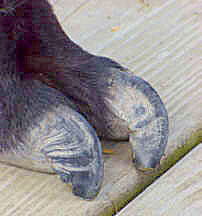 |
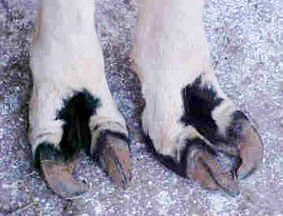 |
|
Very Long, Overgrown Toenails |
| |
Toenail trimming should be part of your routine herd management program. Just
how often a llama's nails need trimming depends on each animal and also the
surfaces they walk on. If they walk over concrete or are on the trail a lot, their nails
will file down somewhat and probably need trimming less often than those animals
that are on soft pasture all the time. Some animal's nails just seem to grow faster
than others regardless of the surfaces they walk on.
Although some llamas may be desensitized or trained so well that you may be able
to pick up their feet and trim their nails with no problem, other llamas will need a
restraint of some kind. Even when placed in a chute of some kind, some llamas will
give you no problem and be very agreeable to trimming their nails. I recommend not
doing this procedure in extremely hot weather or in late gestation as the animal will
probably not be too agreeable to being bothered.
Front Leg: Standing at the llama's side facing toward his tail, begin by touching the
llama high on the leg and giving him the command "foot" (or whatever you may have
used when training) to let him know what your intentions are. If you just bend down
and grab his leg out from under him, he probably will be frightened and will not be
co-operative at all.
Being completely relaxed yourself, somewhat slowly, but firmly, work your hand down his leg, asking for his
foot, take it by the ankle, and lift it straight up and back, bending his leg at the knee as the leg would
normally bend. Don't pull it up extremely high or out to the side....this may be painful and also may put the animal off balance. The animal will respond much better if you bend down to do the trimming and not raise his foot up to your height. This position is harder on your back but results in much more positive results. Let his foot relax in the palm of your hand a couple of seconds before you start the trimming. This gives the animal time to relax, time to listen to your calm voice commands, and time to realize that you don't intend to hurt him.
If he struggles
to pull away, try to hold the leg gently until he stops jerking (keep giving him commands to
"stand" and "foot"). It may be helpful to put your shoulder into his body for a more secure hold. When he stops trying to pull his leg away, relax your hold and let the leg or foot just rest in the palm of your hand for a second while your speak calmly to him. Let him know that you're gentle and not going to hurt him. He may fear that you're going to pull his legs out from under him since his legs are an important means of self defense. Flight, or running, is a main defense of this species.
Back Leg: Very similar to above, face toward his tail, rub high on his leg and with a
firm, authoritative motion, move down his leg while talking to him. Pick up the foot
bending the leg at the stifle joint straight back. Again, don't pull the leg out to the
side or up high. Bend way over and trim low. If he is alarmed, hold the leg until he calms down and then proceed with the
trimming.
Long nails will extend beyond the pad on the foot. If extremely long, they will fold
over or curve causing lameness or pain. You want to trim the nail back just even
with the pad using a nail trimmer similar to pruning shears. Trim the sides of the nail
even with the pad in two or three cuts or whatever is needed. Then make one final cut across the
point taking care not to cut into the pad or the quick. If cut too short, the nail will
bleed, will be painful, and could possibly get infected. If you do see blood, go ahead
and finish the trimming being careful not to get that close again. The bleeding will
have probably stopped by the time you have finished. If not, apply pressure and
disinfect with some iodine. There also is a Blood Stopping Powder if bleeding continues. This product works well, but it will stain floor surfaces. |
Trimming the Nails
|
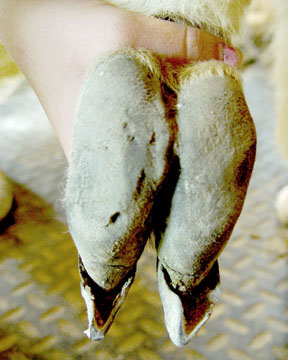
Long nails extend beyond the pad. |
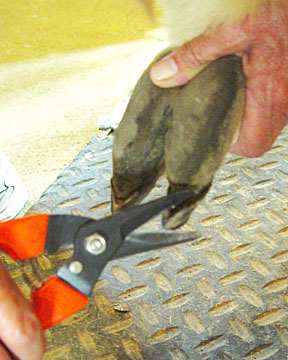
Trim along each side of the nail. |
|
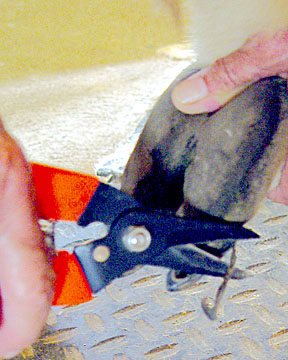
Trim the sides of the nail taking off small
pieces
at a time. Trim until the nail
is even with the pad of the foot. |
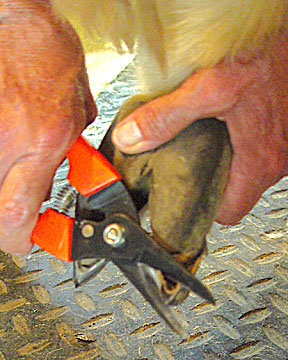
After trimming the side, trim across the
top
so the nail is even with the pad. |
|
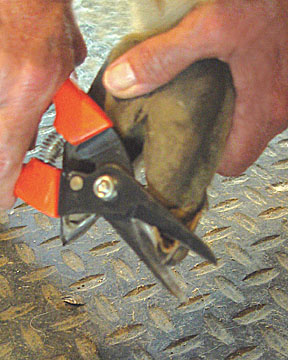
Lastly, cut off the pointed tip of the nail. |
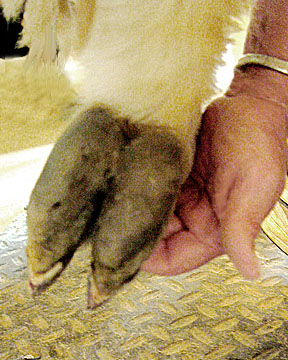
A finished toenail trimming! |
|
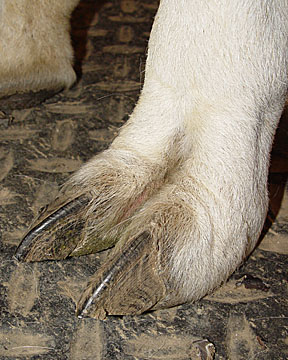
A nice pedicure! |
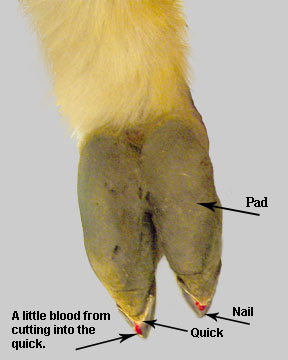
The quick is the living flesh under the
fingernail or toenail that is highly sensitive
to pain. When the nail is cut too short, there will be
some blood. |

|
Dropped Pasterns ..... |
|
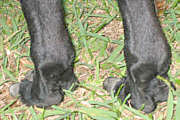
Upright, Vertical Pastern |
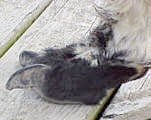
Soft or Dropped Pastern |
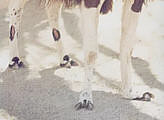
Completely Dropped Pastern |
The pastern is the area between the fetlock and the foot. An area of tendons
and ligaments, the pastern is the shock absorber for the fetlock. When viewed from the side, the pasterns should be vertical with very little angle. When an angle starts to develop in the pastern, it is termed a "soft pastern" and the animal is considered unsound. Although the animal's movement may not be hindered or he may not appear to be in any pain, he should be retired from packing, driving, or excessive activities at this time. You'll probably notice the animal selecting a slower pace and not wanting to run. As time goes on, the pastern can completely "drop" as seen in the one photograph. Arthritis can set in the compromised joint and result in a painful condition. Although this soft pastern is seen in some older animals, many animals are still very upright and strong in their old age. The cause is thought to be possibly hereditary, or possibly the animal started packing too much weight at an early age, or perhaps started cart driving too early, or even perhaps caused by carrying extra weight through numerous pregnancies. Obviously, an animal that is overweight may have more problems in this area. There are some horse products containing glucosamine that may offer the llama some relief if added to their diet. |
|

|
Pad Problems .....
Occasionally, when the weather has been exceptionally wet and muddy,
llamas and alpacas will develop a condition on the pads of their feet that some
owners refer to as "foot rot". The pads will get areas that are
sloughing off or peeling and may actually get areas with holes in the pad.
Examine closely - you may smell the odor of an infection. This condition
may possibly be
a fungus from the wet, muddy weather.
For treatment of this condition on their pads, we wash well with a Batadine
Scrub and then apply Kopertox which has a drying affect. If this treatment is done daily, you will
probably see results quickly. If the foot is in extremely poor condition,
first apply the Koppertox and then apply a coating of Ichthammol, a thick
tar-like salve which has a drawing effect. Put a medical pad bandage over
the pad and wrap the foot with vet wrap to hold the pad in place and to keep it
dry. When conditions are wet, it would be
best to move the animal to a dry area or stall. Apply this treatment
daily. You should see improvement very soon.
Some owners suggest using a carpet remnant soaked with a
diluted Clorox at the entrance to their barn as a preventive of this condition
during periods of wet weather. As the animals walk on the carpet, the
Clorox solution tends to dry out their feet and also sanitize them from any
fungus that may be starting.
|
|
Treatment for the Pad |
|
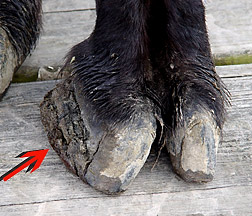
Growth out to the side of pad.
|
|
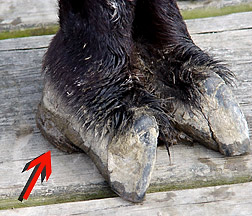
Growth on the bottom of pad.
|
|
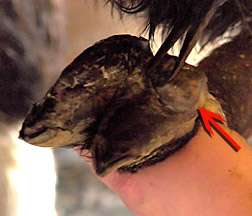
Trimming off the bottom tissue.
This is not painful to the animal.
|
|
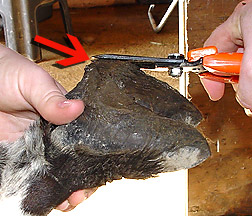
Trimming the side tissue.
|
|
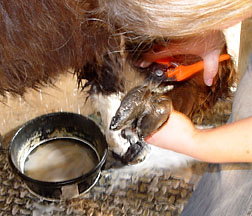
Dish is a clorox/water bath to soak foot.
|
|
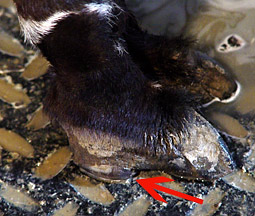
After Trimming
|
| |
|
|
| |
|
|
|

Return To Vet Info |

Return To Llama Management |

Return To Shagbark Ridge Llamas |
Disclaimer
All information on this website is provided as a public service, but we
cannot guarantee that this information is current or accurate. Readers
should consult with their veterinarian before acting on any treatments.
This document is copyrighted by Shagbark Ridge Llamas and no
part may be copied to another homepage. Permission is granted to link
to this page, copy this document in electronic form, or to print it for
personal use provided that this copyright notice is not altered or removed.
Updated Frequently
© 1996/2018 Shagbark Ridge Llamas/Hamilton Co. Llamas

|